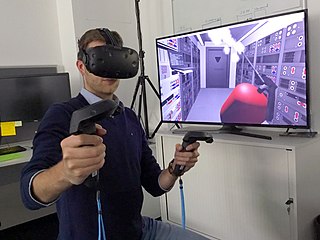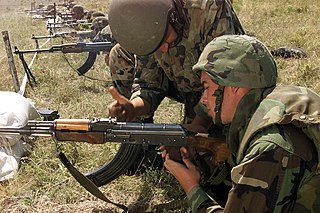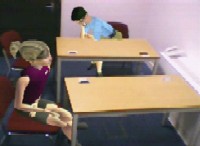Massively multiplayer online role-playing games (MMORPGs) are a combination of role-playing video games and massively multiplayer online games in which a very large number of players interact with one another within a virtual world.

Virtual reality (VR) is a simulated experience that can be similar to or completely different from the real world. Applications of virtual reality can include entertainment and educational purposes. Other, distinct types of VR style technology include augmented reality and mixed reality.

A squad automatic weapon (SAW), also known as a section automatic weapon or light support weapon (LSW), is a fully automatic firearm used to give infantry squads or sections a man-portable source of fully automatic firepower. Weapons used in this role are often selective-fire rifles, usually fitted with a bipod and heavier barrel to perform as light machine guns. Squad automatic weapons usually fire the same cartridge as the assault rifles or battle rifles carried by other members of the unit. This reduces logistical requirements by making it only necessary to supply one type of ammunition to a unit. Squad automatic weapons are light enough to be operated by one person, as opposed to heavy machine guns such as the M2 Browning, which fire more powerful cartridges but require a crew to operate at full effectiveness.
A simulation is an approximate imitation of the operation of a process or system; that represents its operation over time.

A military is a heavily armed, highly organised force primarily intended for warfare, also known collectively as armed forces. It is typically officially authorized and maintained by a sovereign state, with its members identifiable by their distinct military uniform. It may consist of one or more military branches such as an army, navy, air force, space force, marines, or coast guard. The main task of the military is usually defined as defence of the state and its interests against external armed threats.

The military–industrial complex (MIC) is an informal alliance between a nation's military and the defense industry that supplies it, seen together as a vested interest which influences public policy. A driving factor behind this relationship between the government and defense-minded corporations is that both sides benefit—one side from obtaining war weapons, and the other from being paid to supply them. The term is most often used in reference to the system behind the military of the United States, where it is most prevalent due to close links between defense contractors, the Pentagon and politicians and gained popularity after a warning on its detrimental effects in the farewell address of President Dwight D. Eisenhower on January 17, 1961.

Mixed reality (MR) is the merging of real and virtual worlds to produce new environments and visualizations, where physical and digital objects co-exist and interact in real time. Mixed reality does not exclusively take place in either the physical or virtual world, but is a hybrid of reality and virtual reality, encompassing both augmented reality and augmented virtuality via immersive technology.
z/VM is the current version in IBM's VM family of virtual machine operating systems. z/VM was first released in October 2000 and remains in active use and development as of 2019. It is directly based on technology and concepts dating back to the 1960s, with IBM's CP/CMS on the IBM System/360-67. z/VM runs on IBM's IBM Z family of computers. It can be used to support large numbers (thousands) of Linux virtual machines.
Hull speed or displacement speed is the speed at which the wavelength of a vessel's bow wave is equal to the waterline length of the vessel. As boat speed increases from rest, the wavelength of the bow wave increases, and usually its crest-to-trough dimension (height) increases as well. When hull speed is exceeded, a vessel in displacement mode will appear to be climbing up the back of its bow wave.

In politics and military planning, a war effort refers to a coordinated mobilization of society's resources—both industrial and human—towards the support of a military force. Depending on the militarization of the culture, the relative size of the armed forces and the society supporting them, the style of government, and the popular support for the military objectives, such war effort can range from a small industry to complete command of society.

A submarine hull has two major components, the light hull and the pressure hull. The light hull of a submarine is the outer non-watertight hull which provides a hydrodynamically efficient shape. The pressure hull is the inner hull of a submarine that maintains structural integrity with the difference between outside and inside pressure at depth.
Virtual reality therapy (VRT), also known as virtual reality immersion therapy (VRIT), simulation for therapy (SFT), virtual reality exposure therapy (VRET), and computerized CBT (CCBT), is the use of virtual reality technology for psychological or occupational therapy and in affecting virtual rehabilitation. Patients receiving virtual reality therapy navigate through digitally created environments and complete specially designed tasks often tailored to treat a specific ailment. Technology can range from a simple PC and keyboard setup, to a modern virtual reality headset. It is widely used as an alternative form of exposure therapy, in which patients interact with harmless virtual representations of traumatic stimuli in order to reduce fear responses. It has proven to be especially effective at treating PTSD. Virtual reality therapy has also been used to help stroke patients regain muscle control, to treat other disorders such as body dysmorphia, and to improve social skills in those diagnosed with autism.
CP-40 was a research precursor to CP-67, which in turn was part of IBM's then-revolutionary CP[-67]/CMS – a virtual machine/virtual memory time-sharing operating system for the IBM System/360 Model 67, and the parent of IBM's VM family. CP-40 ran multiple instances of client operating systems – particularly CMS, the Cambridge Monitor System, built as part of the same effort. Like CP-67, CP-40 and the first version of CMS were developed by IBM's Cambridge Scientific Center (CSC) staff, working closely with MIT researchers at Project MAC and Lincoln Laboratory. CP-40/CMS production use began in January 1967. CP-40 ran on a unique, specially modified IBM System/360 Model 40.
The virtuality continuum is a continuous scale ranging between the completely virtual, a virtuality, and the completely real, reality. The reality–virtuality continuum therefore encompasses all possible variations and compositions of real and virtual objects. It has been described as a concept in new media and computer science, but in fact it could be considered a matter of anthropology. The concept was first introduced by Paul Milgram.
The virtual world Second Life has its own economy and a virtual token referred to as Linden Dollars (L$). In the SL economy, users buy from and sell to one another directly, using the Linden, which is a closed-loop virtual token for use only within the Second Life platform. Linden Dollars have no monetary value and are not redeemable for monetary value from Linden Lab. A resident with a surplus of Linden Dollars earned via a Second Life business or experiential play can request to refund their Linden Dollar surplus to PayPal. This economy is independent of the price of the game, which users pay to Linden Lab, not to each other. Linden Lab reports that the Second Life economy generated US$3,596,674 in economic activity during the month of September 2005, and as of September 2006 Second Life was reported to have a GDP of US$64,000,000.

Conquest is the act of military subjugation of an enemy by force of arms.
An arms race occurs when two or more nations participate in interactive or competitive increases in "persons under arms" as well as "war material". Simply defined as a competition between two or more states to have superior armed forces; a competition concerning production of weapons, the growth of a military, and the aim of superior military technology.
Software-defined storage (SDS) is a marketing term for computer data storage software for policy-based provisioning and management of data storage independent of the underlying hardware. Software-defined storage typically includes a form of storage virtualization to separate the storage hardware from the software that manages it. The software enabling a software-defined storage environment may also provide policy management for features such as data deduplication, replication, thin provisioning, snapshots and backup.

India–Lebanon relations are warm and cordial. Lebanon maintains an embassy in New Delhi, whilst India maintains one in Beirut.

Virtual reality applications are applications that make use of virtual reality (VR). VR is an immersive sensory experience that digitally simulates a remote environment. Applications have been developed in a variety of domains, such as education, architectural and urban design, digital marketing and activism, engineering and robotics, entertainment, fine arts, healthcare and clinical therapies, heritage and archaeology, occupational safety, social science and psychology.









